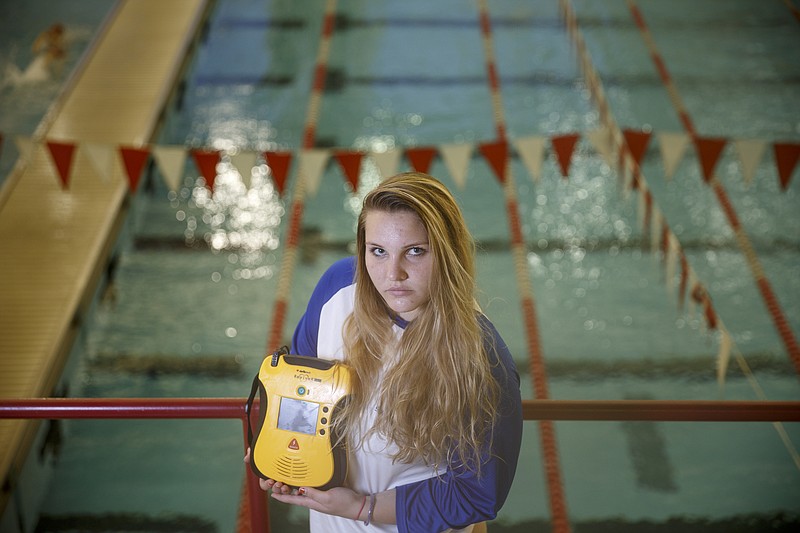I just thought about what if one of our students had a cardiac emergency and we had no access to an AED. It would be a disaster for my school, and I don't want that.
The news that Baylor student Sumner Smith had died after collapsing at a swim team practice hit Cayce Grall hard. The two had been lifeguards together and he was a fellow swimmer in Chattanooga's close-knit competitive swimming community.
Smith, 16, died Oct. 5 after suffering cardiac arrest, despite efforts of Baylor staff to revive him using CPR and a portable defibrillator.
Grall was impressed that the private school had what is known as an automated external defibrillator readily available and the device kept Smith alive long enough for medical personnel to at least have a chance of saving his life. Baylor has five of the devices scattered around its large campus, according to school spokeswoman Barbara Kennedy.
"It inspired me that if someone like that could go through this situation with his heart I felt I had to do something about it," Grall said in an interview Wednesday.
So Grall, a senior at Chattanooga School for the Arts and Sciences, wondered what was available at her public school.
What she discovered was upsetting - the school had a defibrillator, but it was so old the company that manufactured it would no longer service it, she said.
Making matters worse, it was located in administrative offices that were locked in the evenings when many sporting events take place.
Besides, she said, "Our school is so big that an AED in the main office, it would take forever to get to it."
To change that situation, Grall decided to focus her senior project on increasing awareness of the need for defibrillators at all Chattanooga public schools.
She has a lot of work to do, according to Marla Thomas, a nurse at Erlanger hospital who specializes in heart problems. Thomas also is mentoring Grall on the project.
Thomas is a member of the Nurses Education Committee, a group of nurses from all three major hospitals and EMS services who, for the past three years, has been trying to get more defibrillators into local schools. The group has bought more than a dozen defibrillators itself, and two nurses from the group are set to appear before the Hamilton County school board today to urge members to buy even more.
AEDs "should be in every public school, especially where there are sporting events or other physical activities," Thomas said. "With so many heart conditions, they are not detected at birth, but show up later in a child's life."
Tennessee does not require schools to have an AED, according to Ken Wilkerson, director of Hamilton County Emergency Medical Services. Anyone who does have one is supposed to register it with his office so ambulance dispatchers can help people who are treating a cardiac arrest victim find it before the ambulance arrives.
Wilkerson said he does not know exactly how many Hamilton County schools have the devices, although he estimated the number was more than half and perhaps as many as three-quarters. But he agreed, they should be everywhere.
"I would love to see them in every school, mall and stadium," he said.
Automated external defibrillators come with voice recordings that guide users through the several steps needed to activate the device. If the sensors determine someone's heart is beating irregularly, small pads are placed on the victim's chest and the device administers an electric shock intended to stop the irregular heartbeat. The heart will either then restart its normal rhythm or CPR will be required to get it going, Wilkerson said. The defibrillators cost between $1,200 and $2,500 and usually come in a small carrying case roughly the size of a laptop computer.
When they work, they often save lives. Thomas cites the case of an Ooltewah high school student who collapsed on the basketball court three years ago but who was saved by the coaching staff using an automated external defibrillator.
Wilkerson mentioned an incident at McCallie School where the coaching staff saved the life of a student's grandfather who was watching a game.
But Thomas worries a push won't be made to require them in every area school until something bad happens and the school system is left facing a major lawsuit.
"All of the saves get the publicity," she said. "It's the one time it is going to happen and there is not an AED that I worry about."
For now, Grall is taking matters into her own hands. She is launching a fundraising drive to buy at least one of the devices for her school.
"I just thought about what if one of our students had a cardiac emergency and we had no access to an AED," she said. "It would be a disaster for my school, and I don't want that."
Contact reporter Steve Johnson at sjohnson@timesfreepress.com, 423-757-6673, on Twitter @stevejohnsonTFP or on Facebook, stevejohnsonTFP.
